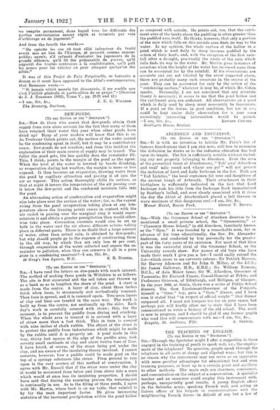[To THE EDITOR OF THE 4 ` SPECTATOR."] have read the
letters on dew ponds with much interest. The method of making these ponds in Wiltshire is as 'follows. The site is first excavated and the soil taken out thrown up as a 'bank so as to lengthen the shore of the pond. A start is Made from the centre. A. layer of clay, about three inches thick when loose, is strenuously and methodically rammed. Then lime is spread, and it is rammed again. Two more layers of clay and lime are treated in the same way. The work is built up from the centre, not sectionally up the sides. Each day's work is carefully covered with straw; this, for the moment, is to prevent the puddle from drying and cracking. When the whole area is treated it is covered with a layer of straw more than a foot thick. This in turn is covered with nine inches of chalk rubble. The object of the straw is to protect 'the puddle from indentations which might be made by the rubble until it is properly set. A pond made in this way, thirty feet square at the edge of the puddle area, took seventy small cartloads of clay and about twelve tons of lime. I have heard, of course, of the straw being put under the clay, and am aware of the insulatingtheory involved. I cannot conceive, however, how a puddle could be made good on the top of a springy substance like straw. Firm ground to ram upon is the very essence of this method of construction. I agree with Mr. Russell that if the -straw were under the clay it would be moistened from below and from above into a mass which would at once lose its insulating properties. I should have said that during the ramming process the watering-pot is continually in use. As to the filling of these ponds, I agree with 'Mr. Martin, whose book is on my table, that rainfall is by far the most important factor. He gives interesting statistics of the increased precipitation within the pond hollow as compared with outside. He points out, 'too, that the catch- ment area of the banks above the puddling is often greater than the puddled area itself. He thinks, however, that only a portion of the rain which falls on this outside area finds its way to the water. In my opinion, the whole surface of the hollow in a pond -which 'is used daily by sheep becomes puddled by the action of their hoofs, and, with the exception of the first rain- fall after a drought, practically the whole of the rain which .falls finds its way to the water. Mr. Martin gives instances of 'occasions when the height of the water has increased more than can be accounted for by the rainfall. If his observations are -accurate and are not vitiated by the error suggested above, 'there are probably many such occasions in the course of the year. They can be accounted for only by the action of the " condensing surface," whatever it may be, of which Mr. Cohen speaks. Personally, I am not convinced that any scientific theory is necessary; it seems to me that the pond hollow and the catchment area are sufficient. All observations on a pond which is daily used by sheep must necessarily be inaccurate. If a pond on the downs, in good condition, but not in use, could be kept umler daily observation for a year some exceedingly interesting information would be gained.


































 Previous page
Previous page